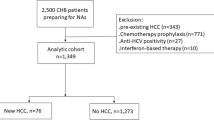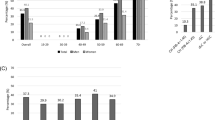Abstract
Chronic infection with hepatitis C virus (HCV) can result in both hepatic and extrahepatic disease and endocrine dysfunction represents an important class of HCV-related extrahepatic disease. The most frequently occurring—and clinically important—of these endocrine disorders are thyroid disease and type 2 diabetes mellitus. In this Review, we evaluate the evidence in support of a link between HCV infection and endocrine-system dysfunction, and discuss potential pathophysiological mechanisms. A meta-analysis of the literature has revealed significant associations between chronic HCV infection, thyroid autoimmunity and hypothyroidism. Furthermore, a high prevalence of thyroid cancer has been reported in HCV-positive patients. Several clinicoepidemiological studies have demonstrated that chronic HCV infection could lead to the development of type 2 diabetes mellitus, possibly as a result of HCV-induced metabolic disturbances. Some researchers have postulated that a type 1 T-helper -cell mediated immune response underpins the association of chronic HCV infection with endocrine disease. Indeed, the available data suggest that a common immunological, type 1 T-helper cell pattern of cytokine expression and activation (via interferon-γ) could provide the pathophysiological basis for this association. Nonetheless, additional studies will be necessary to elucidate fully all the mechanisms involved in HCV-related endocrine dysfunction.
Key Points
-
A high prevalence of autoimmune thyroid disorders and hypothyroidism has been reported in patients with chronic hepatitis C virus (HCV) infection
-
Female sex is a risk factor for autoimmune thyroid disorders; female sex and thyroid peroxidase antibody positivity are major risk factors for hypothyroidism
-
An increased prevalence of papillary thyroid cancer has been reported in HCV-positive patients with thyroid autoimmunity
-
HCV-related type 2 diabetes mellitus occurs in association with hepatic steatosis, insulin resistance and high levels of both tumor-necrosis factor and CXCL10
-
HCV-related gonadal alterations, such as erectile dysfunction and low levels of adrenal–gonadal androgens, have been reported in some preliminary studies
-
A common T-helper 1 immune pattern could provide the pathophysiological basis of the association between HCV and endocrine disease
This is a preview of subscription content, access via your institution
Access options
Subscribe to this journal
Receive 12 print issues and online access
$209.00 per year
only $17.42 per issue
Buy this article
- Purchase on Springer Link
- Instant access to full article PDF
Prices may be subject to local taxes which are calculated during checkout



Similar content being viewed by others
References
Ferri C et al. (2007) B-cells and mixed cryoglobulinemia. Autoimmun Rev 7: 114–120
Sansonno D et al. (2007) Hepatitis C virus infection, cryoglobulinaemia, and beyond. Rheumatology (Oxford) 46: 572–578
Antonelli A et al. (2008) HCV infection: pathogenesis, clinical manifestations and therapy. Clin Exp Rheumatol 26 (Suppl 48): S39–S47
Antonelli A et al. (2008) Immunopathogenesis of HCV-related endocrine manifestations in chronic hepatitis and mixed cryoglobulinemia. Autoimmun Rev [10.1016/j.autrev.2008.07.017]
Pateron D et al. (1992) Latent autoimmune thyroid disease in patients with chronic HCV hepatitis. J Hepatol 16: 244–245
Antonelli A et al. (2006) Thyroid disorders in chronic hepatitis C virus infection. Thyroid 16: 563–572
Antonelli A et al. (2004) Thyroid disorders in chronic hepatitis C. Am J Med 117: 10–13
Antonelli A et al. (2004) Thyroid involvement in patients with overt HCV-related mixed cryoglobulinaemia. QJM 97: 499–506
Pazienza V et al. (2007) The hepatitis C virus core protein of genotypes 3a and 1b downregulates insulin receptor substrate 1 through genotype-specific mechanisms. Hepatology 45: 1164–1171
Rodríguez-Torres M et al. (2008) Thyroid dysfunction (TD) among chronic hepatitis C patients with mild and severe hepatic fibrosis. Ann Hepatol 7: 72–77
Giordano TP et al. (2007) Risk of non-Hodgkin lymphoma and lymphoproliferative precursor diseases in US veterans with hepatitis C virus. JAMA 297: 2010–2017
Prummel MF and Laurberg P (2003) Interferon-α and autoimmune thyroid disease. Thyroid 13: 547–551
Patzwahl R et al. (2001) Enhanced expression of interferon-regulated genes in the liver of patients with chronic hepatitis C virus infection: detection by suppression-subtractive hybridization. J Virol 75: 1332–1338
Mihm S et al. (2003) Expression of the chemokine IP-10 correlates with the accumulation of hepatic IFN-γ and IL-18 mRNA in chronic hepatitis C but not in hepatitis B. J Med Virol 70: 562–570
Matskevich AA and Strayer DS (2003) Exploiting hepatitis C virus activation of NFκB to deliver HCV-responsive expression of interferons α and γ. Gene Ther 10: 1861–1873
Murata M et al. (2002) Increased frequency of IFN-γ-producing peripheral CD8+ T cells with memory-phenotype in patients with chronic hepatitis C. J Med Virol 67: 162–170
Itoh Y et al. (2001) Clinical significance of elevated serum interferon-inducible protein-10 levels in hepatitis C virus carriers with persistently normal serum transaminase levels. J Viral Hepat 8: 341–348
Shields PL et al. (1999) Chemokine and chemokine receptor interactions provide a mechanism for selective T cell recruitment to specific liver compartments within hepatitis C-infected liver. J Immunol 163: 6236–6243
Butera D et al. (2005) Plasma chemokine levels correlate with the outcome of antiviral therapy in patients with hepatitis C. Blood 106: 1175–1182
Diago M et al. (2006) Association of pretreatment serum interferon gamma inducible protein 10 levels with sustained virological response to peginterferon plus ribavirin therapy in genotype 1 infected patients with chronic hepatitis C. Gut 55: 374–379
Apolinario A et al. (2005) Gene expression profile of T-cell-specific chemokines in human hepatocyte-derived cells: evidence for a synergistic inducer effect of cytokines and hepatitis C virus proteins. J Viral Hepat 12: 27–37
Caturegli P et al. (2000) Hypothyroidism in transgenic mice expressing IFN-γ in the thyroid. Proc Natl Acad Sci USA 97: 1719–1724
García-López MA et al. (2001) Thyrocytes from autoimmune thyroid disorders produce the chemokines IP-10 and Mig and attract CXCR3+ lymphocytes. J Clin Endocrinol Metab 86: 5008–5016
Antonelli A et al. (2004) High levels of circulating CX chemokine ligand 10 are associated with chronic autoimmune thyroiditis and hypothyroidism. J Clin Endocrinol Metab 89: 5496–5499
Antonelli A et al. (2005) Increase of interferon-γ inducible α chemokine CXCL10 but not beta chemokine CCL2 serum levels in chronic autoimmune thyroiditis. Eur J Endocrinol 152: 171–177
Antonelli A et al. (2006) Interferon-gamma-inducible alpha-chemokine CXCL10 involvement in Graves ophthalmopathy: modulation by peroxisome proliferator-activated receptor-gamma agonists. J Clin Endocrinol Metab 91: 614–620
Gowans EJ (2000) Distribution of markers of hepatitis C virus infection throughout the body. Semin Liver Dis 20: 85–102
Bartolomé J (2008) Detection of hepatitis C virus in thyroid tissue from patients with chronic HCV infection. J Med Virol 80: 1588–1594
Antonelli A et al. (2008) High values of CXCL10 serum levels in patients with hepatitis C associated mixed cryoglobulinemia in presence or absence of autoimmune thyroiditis. Cytokine 42: 137–143
Antonelli A et al. (2008) Alpha-chemokine CXCL10 and beta-chemokine CCL2 serum levels in patients with hepatitis C-associated cryoglobulinemia in the presence or absence of autoimmune thyroiditis. Metabolism 57: 1270–1277
Antonelli A et al. (1999) Thyroid cancer in patients with hepatitis C infection. JAMA 281: 1588
Antonelli A et al. (2002) Thyroid cancer in HCV-related mixed cryoglobulinemia patients. Clin Exp Rheumatol 20: 693–696
Montella M et al. (2001) HCV and cancer: a case–control study in a high-endemic area. Liver 21: 335–341
Montella M et al. (2003) Risk of thyroid cancer and high prevalence of hepatitis C virus. Oncol Rep 10: 133–136
Antonelli A et al. (2005) Hepatitis C virus infection: evidence for an association with type 2 diabetes. Diabetes Care 28: 2548–2550
Duberg AS et al. (2005) Non-Hodgkin's lymphoma and other nonhepatic malignancies in Swedish patients with hepatitis C virus infection. Hepatology 41: 652–659
Antonelli A et al. (2007) Thyroid cancer in HCV-related chronic hepatitis patients: a case-control study. Thyroid 17: 447–451
Ferri C et al. (1997) Hepatitis-C-virus infection and cancer. Int J Cancer 71: 1113–1115
Ferri C et al. (2000) Hepatitis C virus, B-cell disorders, and non-Hodgkin's Lymphoma. In Infectious Causes of Cancer: Targets for Intervention 349–368 (Ed Goedert JJ) Totowa: Humana Press
Mori Y et al. (2008) Hepatitis C virus core protein: its coordinate roles with PA28γ in metabolic abnormality and carcinogenicity in the liver. Int J Biochem Cell Biol 40: 1437–1442
Okayasu I et al. (1995) Association of chronic lymphocytic thyroiditis and thyroid papillary carcinoma: a study of surgical cases among Japanese, and white and African Americans. Cancer 76: 2312–2318
Noto H and Raskin P (2006) Hepatitis C infection and diabetes. J Diabetes Complications 20: 113–120
Antonelli A et al. (2004) Type 2 diabetes in hepatitis C-related mixed cryoglobulinaemia patients. Rheumatology (Oxford) 43: 238–240
Mehta SH et al. (2000) Prevalence of type 2 diabetes mellitus among persons with hepatitis C virus infection in the United States. Ann Intern Med 133: 592–599
Mehta SH et al. (2003) Hepatitis C virus infection and incident type 2 diabetes. Hepatology 38: 50–56
Tanaka H et al. (1997) Changes in glucose tolerance after interferon-α therapy in patients with chronic hepatitis C. J Med 28: 335–346
Giordanino C et al. (2008) Incidence of type 2 diabetes mellitus and glucose abnormalities in patients with chronic hepatitis C infection by response to treatment: results of a cohort study. Am J Gastroenterol [10.1111/j.1572-0241.2008.02002.x]
Aytaman A and McFarlane SI (2008) Uncovering glucose abnormalities in people with hepatitis C infection: should oral glucose tolerance test become a standard of care? Am J Gastroenterol 103: 1941–1943
El-Zayadi AR (2008) Hepatic steatosis: a benign disease or a silent killer. World J Gastroenterol 14: 4120–4126
Cammà C et al. (2006) Insulin resistance is associated with steatosis in nondiabetic patients with genotype 1 chronic hepatitis C. Hepatology 43: 64–71
Adinolfi LE et al. (2001) Steatosis accelerates the progression of liver damage of chronic hepatitis C patients and correlates with specific HCV genotype and visceral obesity. Hepatology 33: 1358–1364
Rubbia-Brandt L et al. (2000) Hepatocyte steatosis is a cytopathic effect of hepatitis C virus genotype 3. J Hepatol 33: 106–115
Moriya K et al. (1997) Hepatitis C virus core protein induces hepatic steatosis in transgenic mice. J Gen Virol 78: 1527–1531
Knobler H and Schattner A (2005) TNF-α, chronic hepatitis C and diabetes: a novel triad. QJM 98: 1–6
Shintani Y et al. (2004) Hepatitis C virus infection and diabetes: direct involvement of the virus in the development of insulin resistance. Gastroenterology 126: 840–848
Hussain MJ et al. (1994) Hepatic expression of tumor necrosis factor-α in chronic hepatitis B virus infection. J Clin Pathol 47: 1112–1115
Masini M et al. (2005) Hepatitis C virus infection and human pancreatic β-cell dysfunction. Diabetes Care 28: 940–941
Gale EA (2005) Latent autoimmune diabetes in adults: a guide for the perplexed. Diabetologia 48: 2195–2199
Skowronski M et al. (2006) Hepatitis C virus infection: evidence for an association with type 2 diabetes. Diabetes Care 29: 750
Antonelli A et al. (2002) Autoimmunity to CD38 and GAD in type I and type II diabetes: CD38 and HLA genotypes and clinical phenotypes. Diabetologia 45: 1298–1306
Antonelli A et al. (2006) Hepatitis C virus infection: evidence for an association with type 2 diabetes. Diabetes Care 29: 751
Christen U and Von Herrath MG (2004) IP-10 and type 1 diabetes: a question of time and location. Autoimmunity 37: 273–282
Author information
Authors and Affiliations
Corresponding author
Ethics declarations
Competing interests
The authors declare no competing financial interests.
Rights and permissions
About this article
Cite this article
Antonelli, A., Ferri, C., Ferrari, S. et al. Endocrine manifestations of hepatitis C virus infection. Nat Rev Endocrinol 5, 26–34 (2009). https://doi.org/10.1038/ncpendmet1027
Received:
Accepted:
Issue Date:
DOI: https://doi.org/10.1038/ncpendmet1027
This article is cited by
-
Long-term outcomes and risk factors of thyroid dysfunction during pegylated interferon and ribavirin treatment in patients with chronic hepatitis C infection in Taiwan
BMC Endocrine Disorders (2019)
-
Endocrine disorders associated with hepatitis C virus chronic infection
Reviews in Endocrine and Metabolic Disorders (2018)
-
Improving treatment and liver fibrosis outcomes with metformin in HCV-HIV co-infected and HCV mono-infected patients with insulin resistance: study protocol for a randomized controlled trial
Trials (2016)
-
Thyroid hormone suppresses expression of stathmin and associated tumor growth in hepatocellular carcinoma
Scientific Reports (2016)
-
Current Concepts in Diabetes Mellitus and Chronic Liver Disease: Clinical Outcomes, Hepatitis C Virus Association, and Therapy
Digestive Diseases and Sciences (2016)



